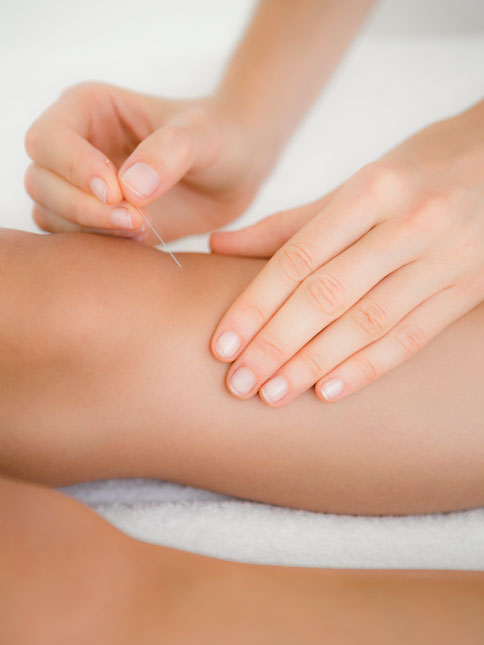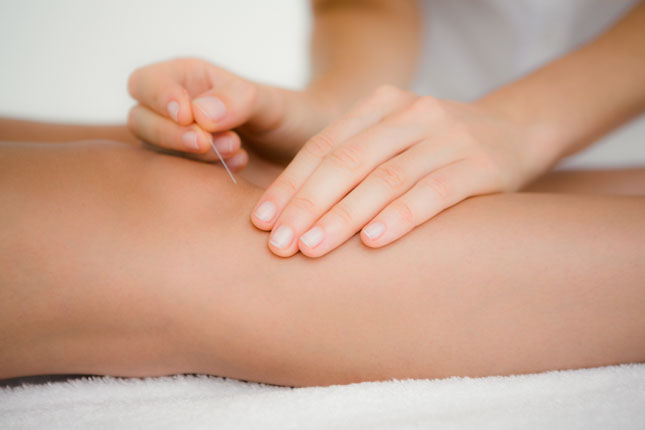A combination of two powerful acupuncture procedures delivers excellent positive patient outcomes for patients with knee osteoarthritis.
Researchers at the Shanghai Jiading District Hospital of Traditional Chinese Medicine conclude that combining standard filiform needle acupuncture with fire acupuncture increases the total effective rate for the treatment of knee osteoarthritis. Standard filiform needle acupuncture achieved an 88.2% total effective rate; however, when combined with fire acupuncture needling, the total effective rate increased to 97.1%.

Acupuncture is effective for the treatment of knee osteoarthritis. Both standard filiform needle acupuncture and fire acupuncture achieve significant positive patient outcomes as standalone therapies. Researchers from the Shanghai Jiading District Hospital of Traditional Chinese Medicine conclude that combining both standard filiform needle acupuncture with fire acupuncture further augments the positive patient outcome rate. Knee osteoarthritis (KOA) is a degenerative joint disease commonly affecting the elderly. Debilitating symptoms of this disease include pain and knee dysfunction, which may eventually lead to disability in walking. KOA patients may therefore experience a decline in their quality of life.
From a Traditional Chinese Medicine (TCM) historical perspective, fire acupuncture is regarded as an effective KOA treatment modality. Studies demonstrate that fire acupuncture effectively mitigates joint pain and swelling and improves physical movements in KOA patients (Li, Xie & Wang, 2011). In fire acupuncture, a specialized needle is heated and is then immediately inserted into designated acupoints in a swift and controlled motion. According to TCM theory, fire acupuncture integrates the principles of acupuncture and moxibustion, thereby producing the medicinal effects of both types of therapy. According to TCM principles, the effects of acupuncture include dredging meridians and expelling pernicious influences from the body, while moxibustion reinforces the yang and dispels cold. Combining standard acupuncture and fire acupuncture therapies provides an integrated effect of warming the meridians, improving the qi of meridians, regulating zang-fu organ functions, enhancing blood circulation, and removing chills and dampness. From a pathological viewpoint, fire acupuncture improves localized blood circulation, reduces inflammation, and eliminates edema, hyperemia, exudation, calcification, contracture, and ischemia.
In TCM, every acupoint has a specific set of therapeutic actions. The Liangqiu acupoint promotes the circulation of qi and blood in the body and activates meridians. The Xuehai acupoint promotes qi and blood circulation and removes excess wind in the body, thus playing a considerable role in restoring knee motor function. Although terms such as wind seem mysterious or antiquated in the western lexicon, in reality, wind refers to specific presentations of pathology. Here, wind references the nature of pain coming and going and the ability of pain to move from joint to joint either suddenly or over time. The Zusanli acupoint has antispasmodic and analgesic effects. The Dubi acupoint dredges blood vessels and reduces pain. The Neixiyan and Heding acupoints warm the meridians and effectively removes the wind element, dampness, and numbness. Administering acupuncture to Ashi acupoints eliminates blood stasis, reduces pain, and has a soothing effect on bone and muscle related pain and inflammation.

Researchers from Shanghai Jiading District Hospital of Traditional Chinese Medicine conducted a study to investigate the efficacy of combining filiform needle acupuncture and fire acupuncture in treating KOA. In the study, KOA patients were divided into three groups, each group receiving one of three different treatments: standard filiform needle acupuncture, fire acupuncture, and combined treatment of standard filiform needle acupuncture with fire acupuncture.
The total effective rate of the three groups were as follows: 88.2% for the filiform needle acupuncture group, 90.6% for the fire acupuncture group, and 97.1% for the combined acupuncture group. From the results, the combined acupuncture group reported the highest treatment effectiveness rate by a significant percentage, pointing towards the conclusion that combined acupuncture therapies considerably improves knee osteoarthritis treatment efficacy.
Selected acupoints for the protocol were the same for all three groups receiving acupuncture treatment. The acupoints were the following:
- Liangqiu (ST34)
- Xuehai (SP 10)
- Heding (EX)
- Dubi (ST35)
- Neixiyan (EX)
- Yanglingquan (GB34)
- Zusanli (ST36)
- Ashi
For the administration of filiform needle acupuncture, the following protocol was conducted. Firstly, 75% ethanol was used to disinfect the skin. Thereafter, 0.30 mm X 40 mm disposable sterile filiform acupuncture needles were swiftly inserted into the Xiyan acupoints with a 45⁰ needle entry angle. For all other acupoints, each disposable needle was inserted vertically between a depth of 0.5 – 1.2 inches untill the patient felt a deqi sensation: localized numbness, soreness, swelling, ache, electrical sensation. Upon a achieving deqi sensation, the acupuncturist applied mild reinforcement and attenuation techniques. Needle retention time was thirty minutes per acupuncture session. The acupuncture treatment was administered once every two days, three times per week. The entire course of treatment comprised four weeks.
For the administration of fire acupuncture, the following protocol was conducted. Firstly, the patient rested in a supine position with knees bent at an angle of 70 to 90 degrees. The acupuncturist then felt for painful Ahshi acupoints by using the right thumb to press on the body. 75% ethanol was used to disinfect the knees. The acupuncturist held an ethanol lamp in the left hand and a 0.40 mm X 35 mm fire needle in the right hand. The ethanol lamp was used to heat a third of the fire needle. When the color of the needle changed from red to white, it was immediately inserted and instantly removed (within 0.5 seconds), with no retention. The depth of needle penetration varied between 0.3 cm to 0.5 cm, dependent upon each individual acupoint’s requirement and individual patient tolerances. The acupuncture treatment was administered once every two days, three times per week. The entire course of treatment comprised four weeks.
For the administration of combined standard filiform needle acupuncture and fire acupuncture, the protocol for standard filiform needle acupuncture was conducted first. After the 30 minute retention time of the filiform needle, the protocol for fire acupuncture was conducted. The combined therapy followed the same frequency and duration of treatment: once every two days, three times per week, for a total of four weeks.
Acupuncture therapy is effective in treating KOA. The results produced by the Shanghai Jiading District Hospital of Traditional Chinese Medicine demonstrated that combined filiform needle and fire acupuncture therapy had a greater effect in KOA treatment than the individual therapies as standalone procedures. Based upon the clinical results, researchers prove that acupuncture is an effective form of treatment for knee osteoarthritis. Further, building upon the success of established individual acupuncture therapies in treating this disease, combining therapies increases the effectiveness of treatment.
References:
Tao SP, He TF, Luo YB, Zhou YL, Duan XD, Song YH, Ding JL, Tang XY. Observations on the efficacy of fire acupuncture plus filiform needle acupuncture in treating knee osteoarthritis. Shanghai Jiading District Hospital of Traditional Chinese Medicine, 2013, 32 (9).
Li B, Xie XC, Wang LP. (2011). Fire acupuncture in treating Knee Osteoarthritis. Beijing Journal of TCM. 30(12):923-925


